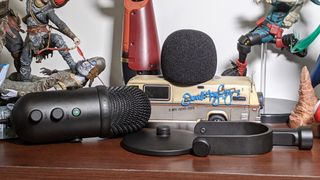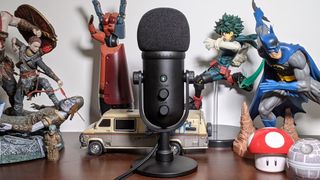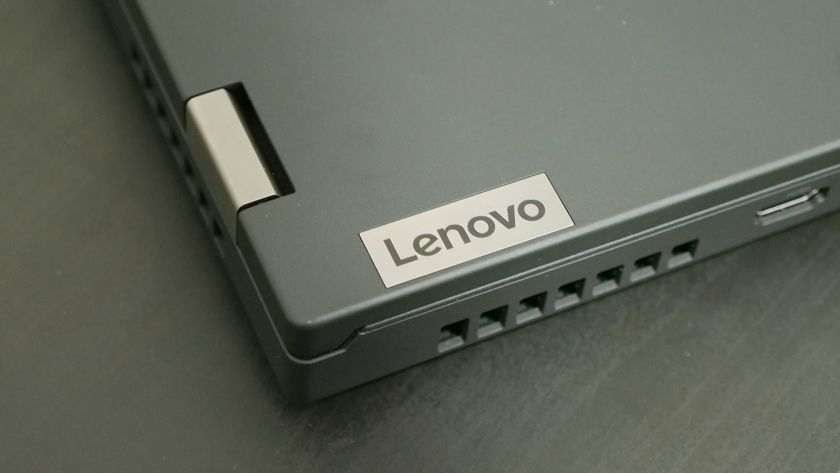Laptop Mag Verdict
The Razer Seiren V2 Pro would be a decent microphone for under $100, but it’s a poor option at its retail price of $150.
Pros
- +
Decent sound after tinkering
- +
USB Type-C connectivity
- +
Includes windscreen
- +
Microphone-monitoring via software
- +
Sleek design
Cons
- -
Sound isn't as good as competitors
- -
Software is scant
- -
Too many PC entries
- -
Expensive
Why you can trust Laptop Mag
You’d be hard-pressed to find one of the best USB microphones that isn’t a Blue Yeti, but Razer just launched the Razer Seiren V2 Pro with the hope of bucking the trend. So how does that stack up? Unfortunately, not very well.
Don’t get me wrong, I love that the Razer Seiren V2 Pro features USB Type-C connectivity in a sleek design. It also sounds decent after you've done some tinkering, lets you monitor your mic through an app, and comes with a windscreen.
However, the sound doesn’t compare to the likes of the Blue Yeti X, nor is the software as useful. And those issues are all the more glaring when you see its $150 price. Not to mention that plugging the microphone in feels like giving your PC a virus when it submits over 10 input/output entries.
Overall, the Razer Seiren V2 Pro is a decent microphone, and I would even call it a good one if not for the $150 price. Until you see a 50% discount, I would avoid it.
Razer Seiren V2 Pro design
All black everything. The Razer Seiren V2 Pro is a cute, short and stubby microphone that has a sleek black frame, microphone grill –– even a blacked-out Razer logo. There are two knobs, one for volume and the other for the gain, both of which are also blacked-out. The only part that stands out is the mute button that sits above the knobs, which glows green when the mic is hot and red when it’s muted.

For the price, I was hoping to see some LED indicators for the gain and volume, but there aren’t even notches to give you the subtlest idea of what you’re changing. These knobs are practically useless –– you might as well do everything within Razer Synapse.
On the opposite side of the microphone is a headphone jack for monitoring and a USB Type-C port for power. The Type-C port is stylishly designed so the cord sits flush with the base, which gives it a clean look.

The Razer Seiren V2 Pro comes in three pieces. Two of them are already attached out of the box: the microphone itself and the arm that connects it. You can attach the arm to the included base (the third piece) or attach it to a boom arm. You can remove the arm by twisting off the knobs to the left and right, which leaves you with just the microphone, which features a 5/8-inch thread at the bottom.
Razer Seiren V2 Pro performance
The Seiren V2 Pro’s 30-millimeter dynamic, cardioid microphone had a lot to live up to, when going against beasts like the Blue Yeti X. However, I was not impressed by the Razer Seiren V2 Pro, and neither were my coworkers.

When I swapped from my Blue Yeti X to the Razer Seiren V2 Pro, both of my coworkers started criticizing the sound, stating that I sounded distant and echoey. One of them said that my voice was flat and lacked depth. Eventually, I set up the microphone with some more optimal settings, then dragged my colleagues back into a call with me. I got a “it sounds fine now, but the [Blue Yeti X] is better.” I turned the gain down to 60, maxed out the sampling rate, and pointed the top of the microphone toward me.
Finally, I used the microphone with the Audacity software to hear what I really sounded like. I noticed quite a few issues. Using the Razer Seiren V2 Pro on my desk was not a viable option. I sounded too distant, but when I turned the gain up, I was too loud. So I attached the microphone to my boom arm and brought it in close, and the sound was surprisingly good at that point. However, it took a lot of work to get there, between fiddling with the settings and setting up the boom arm.
Although the Razer Seiren V2 Pro made my voice sound clear, there was certainly a lack of depth, and it didn’t capture the full range of my vocals. It didn’t sound like I was fully present, which is an issue if you’re trying to connect with an audience. The Blue Yeti X is only $15 more, and its audio is leagues ahead of the Razer.
Razer Seiren V2 Pro software
For better or worse, you’re stuck with the Razer Synapse software, like with most Razer products. The software could be better, and it got in my way too often.

With the Razer Seiren V2 Pro you get two tabs: Mic and Stream Mixer. In the former, you can adjust the gain, headphone monitoring, sampling rate (44.1 kHz, 48 kHz or 96 kHz), the High Pass Filter and Analog Gain Limiter.
There’s a lot more going on in the Stream Mixer tab, which lets you manage the output and input of several channels. It was tough to wrap my head around everything. But this tab controls what you’re listening to and presenting to the world, whether it’s the Stream Mix version of the sound, or the raw microphone, or a different channel entirely.
It’s frustrating because the Razer Seiren V2 Pro creates over 10 inputs or outputs on your PC, and navigating them is a nightmare. I will say, though, that I love how you can easily monitor the microphone via the app.
Overall, Razer Synapse isn’t great for cleaning up the microphone quality. For comparison, the Blue Yeti X offers a wide array of settings and presets that guarantee high-quality audio. Additionally, the Razer Seiren V2 Pro is limited to its Cardioid polar pattern, whereas the Blue Yeti X features three additional patterns.
Bottom line
The Razer Seiren V2 Pro is a fine microphone, but it’s not worth the additional Razer tax the company tries to get away with. There are many pros and cons to this mic, but ultimately, it sounds good after tinkering with it, which is the most important thing. However, don’t spend $150 on this microphone when you can buy a better one for about the same price.
Just get a Blue Yeti X for $165, or wait for the Razer Seiren V2 Pro to get a 50% off discount. With that said, the Razer Seiren V2 Pro is a decent option so long as you don't overpay for it.

Rami Tabari is an Editor for Laptop Mag. He reviews every shape and form of a laptop as well as all sorts of cool tech. You can find him sitting at his desk surrounded by a hoarder's dream of laptops, and when he navigates his way out to civilization, you can catch him watching really bad anime or playing some kind of painfully difficult game. He’s the best at every game and he just doesn’t lose. That’s why you’ll occasionally catch his byline attached to the latest Souls-like challenge.



